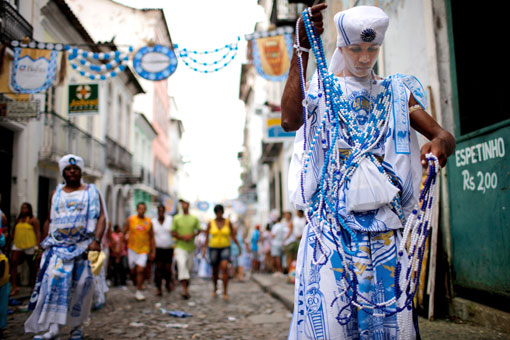Chosen in November 2011 as the Afro-descendent capital of the Americas by leaders of the Encontro Ibero-Americano do Ano Internacional dos Afrodescendentes, Salvador is also the capital of Brazil’s northern Bahia state. Also once the seat of national government after independence, Bahia delights tourists with its historical sites, music, architecture, beaches, cultural diversity, and the renowned hospitality of Baianos.
1. Stroll Through Historic Downtown. Salvador’s historic Pelourinho district is recognized by UNESCO as a World Heritage Site for its architecture and unique preservation of the history of resistance by African slaves in Brazil. Walk on the famous Rua Chile to the Municipal Square and Rio Branco Palace, one of the country’s oldest palaces.
2. Hit the Beach. The beaches north of Salvador, located in the Linha Verde zone, are among the best in Brazil. Imbassaí beach, which means “Path of the River” in the Indigenous Tupy language, is 63 kilometers (39 miles) from Salvador. Take a bus at the central bus station directly to Imbassaí ($5).
3. Dance Samba. Brazilian samba was born in Bahia. Don’t miss the chance to hear authentic beats at the St. George Pub in the Rio Vermelho neighborhood. Afterwards, try the homemade codfish specialty and a world-class Cachaça-based caipirinha. Rua Borges Reis, 60.
4. Ride the Elevator. Salvador is divided into upper town and lower town; the traditional way of exploring the two levels is to take the Lacerda Elevator in the historic center of town. Built in 1873, the elevator has two towers reaching 236 feet (72 meters) high, and carries more than 900,000 people per month. From the top you have a panoramic view of Baía de Todos os Santos. The nominal 80-cent fee is for maintenance.
5. Shop at Mercado Model. At Mercado Modelo, founded in 1912, you’ll find typical Salvadoran arts and crafts: paintings, dolls, musical instruments like drums and berimbau, necklaces, and other ornaments. The market is across from the Lacerda Elevator in Praça Visconde de Cayru.
6. Hit an Afro-Brazilian Bar. Sankofa Café and Bar on St. Michael Hill Road has become one of the most cosmopolitan places in Salvador. The space, created by DJ Sankofa Ghana, is filled with references to African heritage and the diaspora, from food to music.
7. Sample Baiana Food. Aconchego Zuzu restaurant specializes in rich traditional dishes of Bahia. Decorated with scenes of African blocos (local Carnaval music rehearsal venues), the restaurant operates within a small residential village. Hear live music Thursday through Sunday, 8:30–midnight. Rua Quintino Bocaiúva, 18.
8. Enjoy Art. The Museum of Modern Art of Bahia, located in a 17th- century mansion, receives about 200,000 visitors a year to its exhibitions of contemporary Brazilian and Afro-Brazilian art. Inside are works of famous artists like Tarsila do Amaral, Portinari, Di Cavalcanti and Carybé. Open Tuesday to Sunday from 1:00–7:00 p.m., free.
9. Check Out Brazil’s Harlem. Brazil’s version of New York’s Harlem, Liberdade, is one of the largest black-majority neighborhoods in Latin America. It’s also home to the headquarters of Brazil’s oldest Carnaval bloco. Musicians rehearse at Afro Ilê Aiyê ballroom every Saturday of the summer, starting at 10:00 p.m., Ladeira do Curuzu in Liberdade.
10. Retreat for a Day. For a break from Salvador’s bustling cultural life, visit Chapada Diamantina, an oasis in the nearby mountains, where spiritual leaders and backpackers from around the world go to marvel at trippy rock formations and the mystical atmosphere. The Morro do Pai Inácio, at 312 feet (400 meters) high, is one of Brazil’s most spectacular and accessible waterfalls. Buses from Salvador are $30 each way for the five-hour trip.






